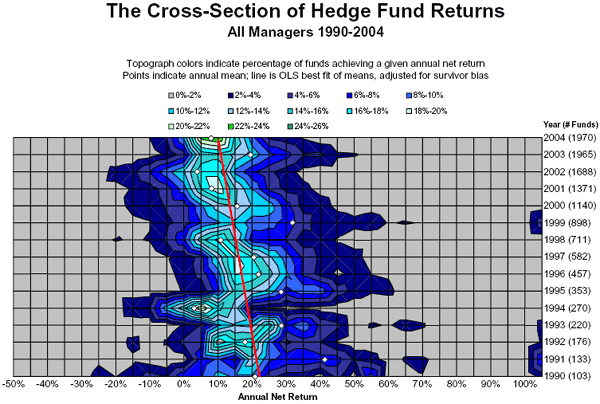In a set of April 2005 charts entitled “The Topography of Hedge Fund Returns”, Craig French and David Abuaf of Corbin Capital Partners, L.P. map the annual returns of a range of hedge fund strategies over the past 15 years. Using data for all hedge funds that existed for all 12 months of each calendar year in the HFR database over 1990-2004, they find that:
- The average annual return for all hedge funds is positive for all years in the period examined, but trending downward.
- Hedge fund returns are currently compressed in an historically narrow range.
- Market neutral funds have maintained fairly steady annual returns averaging in the high single digits.
- The average annual return for funds of funds has declined slightly over the period examined from a little over 10% to a little under 10%.
The following figure from one of the charts (included with permission) summarizes the returns for all hedge fund managers over the past 15 years. The Ordinary Least Squares (OLS) best fit (red line) indicates that the average return for all hedge funds has declined from 20+% in 1990 to about 10% in 2004.

Other charts map the performances of: long/short equity funds; convertible arbitrage funds; event-driven funds; distressed securities funds; financial instrument arbitration funds; market neutral funds; other arbitrage funds; commodity trading funds; global trading funds; and, funds of funds.
Separately, Mr. French offers the following clarification: “One aspect of this work…is that there is significant survivorship bias — first due to survivor bias in the HFR database and additionally due to our method of using only the funds that existed for all 12 months of each calendar year. Most researchers assume that the proper correction for this bias is to reduce the average returns estimated in the study using the rationale that the ignored nonsurvivors would have had worse performance than the mean or median survivors. This assumption may or may not be true, but we also make it in a correction to the slope of the OLS line. The procedure we use is to regress the mean annual returns (dependent variable) on time (independent variable) and then attenuate the slope of the line of best fit by 33.33 basis points (bp) per year cumulatively (no reduction in 2004, 33 bp in 2003, 67 bp in 2002, 100 bp in 2001, etc. all the way to a reduction of 500 bp in 1990). This procedure reflects an assumption [made based on intuition] that survivor bias in the data is stronger earlier.”
In summary, 10% annual return is currently a reasonable hedge fund benchmark.